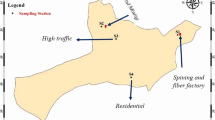Abstract
Penge is an asbestos-contaminated area with a high incidence of asbestos-related diseases amongst its residents due to exposure to airborne asbestos fibres. The following paper presents an assessment of asbestos fibre exposure in the ambient air of the area. The objective of the study was to quantify the level of airborne asbestos fibre concentration in an endeavour to understand the health risk to which residents are exposed. The study was carried out based on air analyses data of the area acquired from the Council for Geoscience as well as health risk assessment techniques guided by the Risk Assessment Guidance for Superfund (EPA, 1989). It was found that the average asbestos fibre concentration in the ambient air of the study area was 0.047 f/mL which is lower than the 0.2 f/mL limit stipulated by the South African government. However, the asbestos fibre concentration in ambient air of the study area is much higher than the 0.0005 f/mL limit stipulated by the World Health Organization. The average cancer risk for all age groups in the study area was 2.08 × 10−3. When compared with the Environmental Protection Agency National Contingency Plan standard which accepts the risks within the range between 10−4 (0.0001) and 10−6 (0.000001), it was found that the results obtained in the study area generally exceed the standard. It is recommended that all of the sources of asbestos in the area be rehabilitated.



Similar content being viewed by others
Data availability
Due to the nature of this research, participants of this study did not agree for their data to be shared publicly, so supporting data is not available.
References
Allen, L.P., Baez, J., Stern, M.E.C. and George, F. (2017). Asbestos economic assessment of bans and declining production and consumption, pg. 1 – 37. World Health Organisation, Copenhagen.
ATSDR (2001). Toxicological Profile for Asbestos, pg. 1 – 318. Department of Health and Human Services, Public Health Service, Agency for Toxic Substances and Disease Registry, Washington DC.
Basson IJ, Koegelenberg C (2017) Structural controls on Fe mineralization at Thabazimbi Mine, South Africa. Ore Geol Rev 80:1056–1071
CSMI (2008). The future of Penge, prospect for the people and the environment, project report and guidelines, pg. 1 - 44. Centre for Sustainability in Mining and Industry, Braamfontein.
DEA (2010). Framework for the management of contaminated land, pg. 1 – 48. Department of Environmental Affairs, Pretoria
DoL (2018). Draft asbestos abatement regulations, pg. 17 – 41. Department of Labour, Pretoria.
DoL (2018). Draft asbestos abatement regulations, pg. 17 – 41. Department of Labour, Pretoria
Felix, M. A., Leger, J. P. and Ehrlich, R.I. (1993). Three minerals, three epidemics – asbestos mining and diseases in South Africa. Advance in modern environmental toxicology. Vol. 22, part 1: The identification and control of environmental and occupational disease, pg. 265 – 279. Princeton Scientific Publishing Company Inc. Princeton, N. J.
Google Earth (2018) Location of Penge, Limpopo -24.383279° 30.289644°, elevation: 692m, 3D map, Topography data, viewed 19 November 2019. http://www.google.com/earth/index.html.
EPA (1989). Risk assessment guidance for superfund volume i human health evaluation manual, pg. 1 – 268. U.S. Environmental Protection Agency, Washington, D.C.
EPA (2011). Early warning report: use of unapproved asbestos demolition methods may threaten public health – report No. 12-P-0125. U.S. Environmental Protection Agency, Washington, D.C.
Hart HP (1988) Asbestos in South Africa.J South Afr Inst Min Metall 88(6):185–198
HSE (2005). Asbestos: the analysts’ guide for sampling, analysis and clearance procedures, pg. 1 – 20. Health and Safety Executive, London.
HSE (2012). The control of asbestos regulations 2012, No. 632, pg. 1 – 28. Health and Safety Executive, London
HSE (2018). Asbestos-related diseases in Great Britain, 2018 Annual Statistics, pg. 1 – 18. Health and Safety Executive, London.
Kwata, M. G., Masindi K., Mtyelwa, O., Malatji, M., Moja, S. J., Motlakeng, T., Malepe, R., Mogudi, L., Ratshalingwa, P. and Ndou, M. (2019). 4th Quarter Report 2018/2019 Integrated rehabilitation monitoring task (unpublished), pg. 4 - 48. Council for Geoscience, Pretoria.
Met One Instruments Inc (2011). E-Sampler particulate monitor operation manual revision L, pg. 5 – 60. Met One Instruments Inc, Oregon.
Miyano T, Beukes NJ (2006) Mineralogy and petrology of the contact metamorphosed amphibole asbestos-bearing Penge Iron Formation, Eastern Transvaal, South Africa. J Petrol 38(5):651–676
Ndlovu N, Naude J, Murray J (2013) Compensation for environmental asbestos-related diseases in South Africa: a neglected issue. Glob Health Act 6(1):19410–https://doi.org/10.3402/gha.v6i0.19410
Nel, J. (2006). The current risk of asbestos exposure to the citizens of the Prieska area, Northern Cape Province in South Africa, pg. 1 – 72. Master’s dissertation, North-West University, Potchefstroom.
NIOSH (1980). Workplace exposure to asbestos: review and recommendations – DHHS (NIOSH) Publication No.81–103. National Institute for Occupational Safety and Health, Centres for Disease Control and Prevention, U.S. Department of Health & Human Services, Washington, D.C.
NIOSH (2018). C – Supplementary exposure limits. National Institute for Occupational Safety and Health, Centres for Disease Control and Prevention, U.S. Department of Health & Human Services, Washington, D.C. Available from https://www.cdc.gov/niosh/npg/nengapdxc.html (Accessed 4 June 2019).
OSHA (2014). Asbestos fact sheet. Occupational Safety & Health Administration, Washington, D.C. Available from https://www.osha.gov/Publications/OSHA3507.html (Accessed 4 June 2019).
Pawełczyk A, František B (2015) Health risk associated with airborne asbestos. Environ Monit Assess 187(428):1–11
Wei B, Yang L, Zhang X, Zhang B, Yu J, Jia X (2012) Airborne crocidolite asbestos fibers in indoor and outdoor air in a rural area, China. Aerosol Air Qual Res 12:1282–1288
WHO (2000). Air quality guidelines for Europe second edition, pg. 1 – 246. World Health Organization Regional Office for Europe, Copenhagen.
Author information
Authors and Affiliations
Corresponding author
Additional information
Publisher's note
Springer Nature remains neutral with regard to jurisdictional claims in published maps and institutional affiliations.
Rights and permissions
About this article
Cite this article
Malatji, M., Moja, S.J., Kwata, M.G. et al. Screening for asbestos fibre exposure in ambient air in Penge, Limpopo. Air Qual Atmos Health 14, 2073–2078 (2021). https://doi.org/10.1007/s11869-021-01079-7
Received:
Accepted:
Published:
Issue Date:
DOI: https://doi.org/10.1007/s11869-021-01079-7




